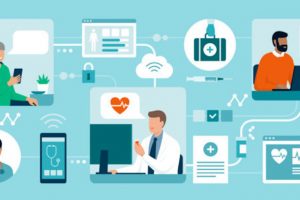Expanding the Healthcare Ecosystem with Digital Capabilities
The US healthcare system has seen great expansion over the past 20 years, particularly driven by the growth of technology and its applications in the industry.  Today, the ecosystem has transformed to support patient choice, enable more personalization and connectivity, and engage care teams in each patient’s care. But does digital capability mean more engagement or just more complexity for patients to manage?
Today, the ecosystem has transformed to support patient choice, enable more personalization and connectivity, and engage care teams in each patient’s care. But does digital capability mean more engagement or just more complexity for patients to manage?
Major players of the healthcare ecosystem
From the beginning, physicians have been the backbone of the healthcare system, with community physician practices and hospitals serving as another entry point into the system. Overtime, insurance companies began to earn greater sway into the system, positioning them as gatekeepers for patients to access certain aspects of care services. As such, these three pillars have been the major players of the healthcare ecosystem.
This approach often left patients as a secondary participant, with little choice or input about their own health. But in recent years, patients began to take more control over their health, putting the power of choice back into their hands with businesses and providers now clamoring to capture their business. The advent of technology has also helped to drive patient engagement in their own health, becoming more aware of their own health status and taking more action. In today’s environment, the patient stands as the center of the healthcare ecosystem, with physicians, healthcare systems, insurance companies all working together to create a connected network of services in support of the patient.
Rethinking the patient position in the system
With patients taking a more active role in their health, and greater competition from providers and health systems, the larger healthcare ecosystem has evolved to support patient choice. And a myriad of sub-industries has also seen growth, creating a greater connected web of health services to support patient choices and various pathways toward improved health. While at times confusing for the consumer, this also offers patients more personalized and custom journeys to engage with their health.
In support of patient choice, new tech products are also ushering in an era of patient awareness and activity. From telehealth services to wearable devices to smartphone applications, the healthcare system is no longer limited to physical structures, and health info is at patients’ fingertips. These new tech advancements provide info and insight to users to actively monitor their health, stay connected to their medication, and track key intervals as part of their daily lives. By enabling patients to track their own health, such measurements are no longer relegated to physician offices and fit more conveniently into patients’ schedules. And advanced connectivity means that the data produced by health tech devices can be shared with physicians to create an advanced brain trust of patient info toward better health.
Growth of digital health to support patients
Throughout the pandemic, especially during periods of lockdown, patients had limited access to care resources. This limitation led to an increase in patients actively managing their own health through digital health solutions. Both Apple and Amazon reported increase in activity of users turning to AI-enabled products to manage health measurements and reduce risks. Many turned to digital drug companions such as Medisafe to receive guidance and support on medication therapy schedules. Using a drug companion also provides a level of accountability and reassurance throughout the medication treatment. Should patients miss a dose or have complications, digital drug companions can connect with caregivers and providers to assist with ongoing care.
Digital drug companions are part of the larger healthcare ecosystem that captures essential patient data and provides assistance outside traditional healthcare spaces. As more digital health tools emerge, they create necessary support and information that comprise patients’ lives to develop a more complex and complete picture of each patient. And through tech advancements, all these new digital resources can share information through a connected system to unite providers, payers, pharmacists, and other providers as part of a patient care team. Now, the patient sits at the center, with more informed insight into their health and able to have advanced conversations with their care team, focused on the proper treatment for them.
The future of the connected healthcare ecosystem
Expansion of the healthcare ecosystem means that more players have a role in delivering care, but it also means that more information is available like never before in order to assist with treatment. The patient journey is no longer linear, and patients have more support and resources available to them to assist throughout the journey. While the system has now evolved into a connected web, patients can also take an active role in their health with digital health solutions that keep members of their care team informed. And the journey no longer ends with a diagnosis, but rather presents the first step of coordinated care throughout their progress. From digital drug companions to wearables to health-at-home, patients have a wealth of resources to ensure modern care fits their lifestyle instead of upending it. The future of healthcare is here, and it’s a connected support system designed to meet the personal needs of each patient.
